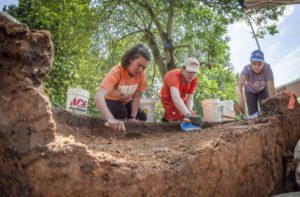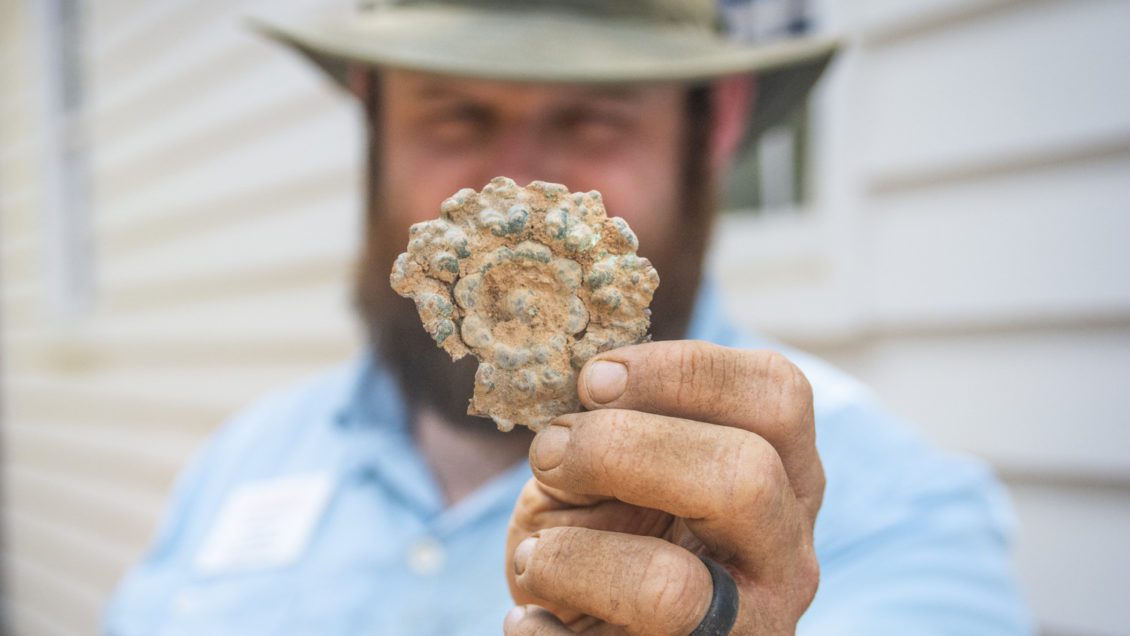CLEMSON – Archaeology students and faculty have returned to Fort Hill this summer to carefully brush away layers of dirt in hopes of revealing some of the long-buried stories of Clemson’s complicated past.

Students have been meticulously digging into the lush green lawn between the “Shoebox” dorms and the historic Fort Hill property—which was home to South Carolina statesman John C. Calhoun and later, University namesake Thomas Green Clemson and their families—in the hopes of uncovering the footprints and remnants of domestic slave quarters and outbuildings such as the laundry, storage rooms and smokehouse that once stood next to the main house.
The project is a joint venture between the Department of Historic Properties (DHP), the Department of Sociology, Anthropology and Criminal Justice (DSACJ) and university facilities. Its goal is to discover what the living experience was like for those enslaved on the property, said Executive Director and Chief Curator, Will Hiott.
Archaeologist David Markus, a lecturer in the Department of Sociology, Anthropology and Criminal Justice, is once again leading the project for students enrolled in the six-week field study.
“We have a lot of narrative history about Calhoun and Clemson, and what they thought about what was going on. What we don’t know is the story from the perspective of the people who were living as slaves. They didn’t have a voice in that record,” Markus said. “What did they eat?What did they wear? What did they do in their free time? What did their living conditions look like? What kind of plates were they eating off of? What kind of jewelry or adornment did they wear? Which religion were they practicing? That’s the kind of thing we’re after.”
Mari Noorai, curator of education and interpretation for Historic Properties, explained that African American research at Fort Hill has been part of the mission of the DHP since the early 1990’s.

“Dr. Carrel Cowan-Ricks was the first to lead students on archaeological inquiry to learn more about the lives of the enslaved African-Americans and the freedmen and women,” said Noorai. “This continued effort reflects on the efforts of Clemson University, its faculty, staff, and students.”
This year Markus and his team have been building on last summer’s dig, which unearthed several small artifacts as well as a pillar footprint of one of the buildings. The team dug out from that first footprint and found four sets of dressed stones that could have been pillars, and one that could have been the part of a doorstep or cornerstone. Markus said the team will use the potential pillar locations as guides to reveal the exact building layouts.
“Next, we’ll take the interior of the structure down all the way. Once we get to substrata, we’ll know exactly what we’re dealing with,” he said.
Junior Carson King, an anthropology major from Lexington, S.C., explained her hopes for the project as she sifted dirt through a screen with her hands, picking out small pieces of glass and other artifacts and placing them into a labeled bag.
“This is my first summer doing this field study. I didn’t really have any expectations, but it’s been really interesting how much we’ve learned already,” she said. “This dig in particular inspires me, because being able to recognize African-American history on campus is a big deal, especially in the South. All of our history is told from the point of view of the plantation owners. We have to face the fact that slavery is a part of our history. This is a way to lift [enslaved persons’] history up a bit and honor them.”

In 2016, Clemson adopted an interpretive plan that stemmed from the work of the University’s History Task Force Implementation Team, which was appointed to address recommendations of the Board of Trustees’ Task Force on the History of Clemson. The board’s recommendations were intended to ensure that the University teach its history in a way that is forthcoming, accurate and beneficial for the entire Clemson Family.
In keeping with those guidelines, Clemson University Historian Paul Anderson said uncovering the forgotten structures of Fort Hill will ultimately produce knowledge that holds a much deeper meaning to the Clemson Family than simple data collection.
“I’ve said many times that the history here is not just institutional or even local,” said Anderson. “When you turn over the soil, what you’re seeing and literally holding in some cases are the deep roots of African-American history at Fort Hill.”
Noorai said that in 1865, prior to emancipation, there were 139 enslaved African Americans laboring at Fort Hill at the time of death of Andrew Pickens Calhoun. Of those, 127 were enslaved field laborers, and 12 were either enslaved domestic laborers or skilled tradesmen “like Nickolas who was the blacksmith, Ted who was the carpenter, Isaac who was the gardener, and Christy who was the cook.”
According to the Call My Name: African Americans in Clemson University History project, conceived by Rhondda R. Thomas, the Calhoun Lemon Professor of Literature, enslaved persons lived and worked on the Fort Hill Plantation as domestics, field hands, valets, gatekeepers, gardeners, blacksmiths, carpenters, carriage drivers and weavers. Between 1868 and 1874, at least 44 freedmen and women–former slaves-signed annual contracts to labor as sharecroppers for Thomas Green Clemson.

“I’m eager to see what artifacts Professor Markus and his students recover during the archaeological dig this summer,” said Thomas. “The history of enslaved African-Americans and the sharecroppers who labored on Fort Hill is a central component of the Clemson story. Learning about their experiences can enable us to better understand the University’s complex history as well as the legacies of slavery on current campus and community relations.”
Participants in the Fort Hill archaeology project hope to honor those lives by uncovering and preserving their stories.
“One of the special things—one of the most important things, actually—about this place is how rich and full and meaningful its past truly is,” said Anderson. “So what’s important, I think, is that the digs can help ground us in a history of place and bring us to a richer understanding of ourselves and our community — and in a sense, to how connected we all are to each other, to peoples past and present, to communities which were here before the University community was here. It’s not grandiose at all but right to the point that the more we discover about everyday life at Fort Hill, the more we discover what a wider, vaster world resides right here among us.”
Get in touch and we will connect you with the author or another expert.
Or email us at news@clemson.edu

